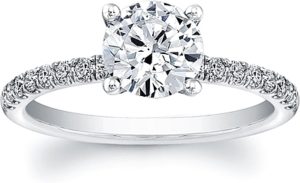
Pavé and Micro-Pavé Settings
What is a Pavé or Micro-Pavé Setting?
Pavé is pronounced “pa-vay” and originates from the French word meaning paved, to best describe the arrangement of diamonds set across the surface. Diamonds are arranged at regular intervals in close proximity and in a uniform arrangement, building up what appears to be a coating of diamonds. Each stone is held within small grains of metal which are invisible to the naked eye. The technique can be used to cover a large area of precious metal, say in a brooch. It is also popular for setting small meleé diamonds within wedding rings and engagement rings. One such example is as the popular “halo engagement ring.

What is the difference between Pavé and Micro-Pavé?
The main difference between pavé and micro-pavé is the size of the diamonds. Micro-pavé settings are created with the smallest stars (fully-cut diamond melee in very small sizes) that are uniform in size and laid out in a honeycomb-like arrangement over the surface. For micro-pave settings the diamonds are smaller than 0.01 carats. For most pave-set rings the diamonds will be between 0.01 and 0.02 carats. Traditional pavé settings utilise an assortment of small melee diamonds in various sizes to best fit the space to be covered and the style of ring being designed.

Best Diamonds for Pavé
In the past eight-cut diamonds would be used to complement larger centre and side stones. These stones were not well suited for pave setting as they do not reflect much light. However, with advances in technology and the ready availability of full-cut diamonds in small sizes with the traditional 57 facets, pave-setting has become much more popular. The multi-dimensional surfaces from the additional facets result in a dazzling effect – any movement of the ring causes light to literally “dance” across the surface of the diamond.

Techniques for Setting
Both pavé and micro-pavé settings require exceptional setting skills. However, modern CAD techniques have provided an effective tool for laying out pre-drilled surfaces. This enables the setter to position each diamond in a pre-positioned hole creating a perfectly even distribution. Traditionally, pavé settings were created by hand, working a flat surface of metal and lifting the small grains of metal from the surface to hold each diamond. This was a very time-consuming and precise technique perfected over many years of training.

Wear and Tear
Pavé and micro-pavé settings are both susceptible to stone-loss. In addition, each retaining metal grain is susceptible to damage from the diamond itself if knocked. However, provided each diamond is accurately set within the piece by a skilled setter and care is taken to avoid knocks, the diamonds should remain within their settings. Having said this, should a diamond be lost from a pavé setting, the cost of replacing it would be minimal since the stones are so small. Cleaning a pave-set item should only be done using a very soft brush, some warm water and a small amount of mild detergent. Ultrasonic cleaning is best avoided since this would most likely shake the diamonds from their settings as the piece vibrates inside the cleaner. It would be wise to avoid pave-settings for rings worn daily or for someone with a very active lifestyle.

